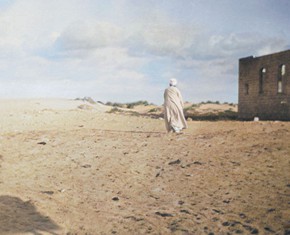The views expressed in our content reflect individual perspectives and do not represent the authoritative views of the Baha'i Faith.
Between his declaration in 1844 and his execution in 1850, life for the Bab and for the Babi community was a whirlwind of activity and, before long, a wildfire of persecution, torture, and martyrdoms.
The Bab’s new Faith spread rapidly among the Persians. Thousands upon thousands ecstatically embraced it, and their conversion from Islam created fear and apprehension among the governmental and ecclesiastical elites, who responded with vicious repression and deadly persecution.
In 1847 the Bab, who had been under various forms of house arrest since his return from pilgrimage to Mecca and Medina in 1845, was imprisoned in the remote mountain fortress of Mah-Ku in the northwest of Adharbayjan.
RELATED: Exiled and Imprisoned, The Bab’s New Faith Spreads
The Bab remained imprisoned there for nine months, after which he was removed to further imprisonment in the fortress of Chihriq, also in Adharbayjan, where he remained for the next two years. On July 9, 1850, he was executed by a government firing squad in the barracks square of Tabriz under miraculous circumstances.
But during the six years of the Bab’s ministry, Baha’u’llah, at the Bab’s behest, steadily guided the Babi Faith to the extent he was able.
The Babi Faith spread with amazing swiftness throughout Persia, making the monarchy, which was closely aligned with the powers of the clergy, sense a frantic need to react swiftly and ruthlessly to obliterate the Faith. By inciting uproar among the citizenry, the mullas encouraged attacks on the homes of the Babis. During the two-year period from 1848-49, approximately twenty thousand Babis were slaughtered, often by unspeakably hideous means. The heart-wrenching accounts of these attacks and the courage and heroism demonstrated by those Babis – who chose death rather than recant their beliefs – can be found recounted in graphic detail in numerous sources.
The highlights of Baha’u’llah’s role in these events is worth noting, though the complexity of his involvement is perhaps best recounted in Hasan Balyuzi’s Baha’u’llah: The King of Glory, at present the most comprehensive biography of Baha’u’llah. In the summer of 1848, Baha’u’llah convened a conference of Babi leaders and followers, ostensibly to consult on how to help rescue the Bab from imprisonment. In reality, the conference had a more subtle and profound purpose – to proclaim to the Babis that the revelation of the Bab was not an attempt at reformation or purification of Islam, but a new independent revelation from God.
In short, if they were to continue to be followers of the Bab, they should no longer consider themselves Moslems, but Babis, and they should recognize the Bab as possessing a spiritual station on a par with that of Muhammad.
In a symbolic gesture on this occasion, all were given new names or titles. At this time Mirza Husayn-Ali assumed the title “Baha’u’llah.” This important conference also set in motion a series of events that would over the course of the following year result in the most grievous attacks on the Babi communities. The most notable of these were the government siege of Fort Shaykh Tabarsi near Barfurush, which spanned the period between October of 1848 to May of 1849; the Zanjan upheaval, which lasted from May 13, 1850 to January, 1851; and the Nayriz upheaval which began on May 27, 1850 and ended on June 21 of that year. In July of 1850, the Bab himself was executed.
As these brutal persecutions spread throughout Persia, almost every Babi leader of note was executed. Deranged by grief at the slaughter of friends and relatives, two young Babis determined to take the life of the Shah. Though their plot was foolhardy and sternly discouraged by Baha’u’llah, the two approached the Shah intent on their purpose, but their weapon misfired. They were quickly seized, tortured, and executed.
While they confessed that they had no accomplices, the firestorm of persecution once again gained momentum throughout Persia, and being one of the few remaining Babi leaders, Baha’u’llah himself was arrested. In spite of his noble rank and respected character, he was placed in Tehran’s infamous subterranean prison the Siyah-Chal, commonly known as the “Black Pit.” An underground dungeon formerly used as a water cistern, this foul smelling enclosure had neither light nor water. His neck in chains, his feet in stocks, Baha’u’llah was strung together in a row with eighty-one others, thirty-eight of whom were leading members of the Babi community. Baha’u’llah’s own description, from his book Epistle to the Son of the Wolf, hints at the grievous conditions they endured:
Upon Our arrival We were first conducted along a pitch-black corridor, from whence We descended three steep flights of stairs to the place of confinement assigned to Us. The dungeon was wrapped in thick darkness, and Our fellow prisoners numbered nearly a hundred and fifty souls: thieves, assassins and highwaymen. Though crowded, it had no other outlet than the passage by which We entered. No pen can depict that place, nor any tongue describe its loathsome smell. Most of these men had neither clothes nor bedding to lie on. God alone knoweth what befell Us in that most foul-smelling and gloomy place!
On a daily basis, one Babi prisoner would be selected, taken out to the courtyard, and executed. As recounted by Shoghi Effendi in The Dawn-Breakers, there was an air of expectation and celebration by the other Babi prisoners as each one left, because Baha’u’llah would “comfort him with the assurance of an everlasting life in the world beyond”:
Soon after the martyrdom of each of these companions, We would be informed by the executioner, who had grown to be friendly to Us, of the circumstances of the death of his victim, and of the joy with which he had endured his sufferings to the very end.
It was clearly only a matter of time before Baha’u’llah himself would be taken.
RELATED: Baha’u’llah: The Founder of the Newest Global Faith
Yet it was during this same period of imprisonment that Baha’u’llah received the signal that the time to initiate his own revelation had come. One night in a dream, the Holy Spirit personified in the form of the Maid of Heaven visited him in this vision and assured him that he would be released, that he would unleash a revelation that would overpower all obstacles, and that in time his revelation would transform the entirety of human civilization on Earth. His own words, taken from his tablet to Nasiri’d-Din Shah alluding to this turning point, describe that remarkable experience:
O King! I was but a man like others, asleep upon My couch, when lo, the breezes of the All-Glorious were wafted over Me, and taught Me the knowledge of all that hath been. This thing is not from Me, but from One Who is Almighty and All-Knowing. And He bade Me lift up My voice between earth and heaven, and for this there befell Me what hath caused the tears of every man of understanding to flow. The learning current amongst men I studied not; their schools I entered not. Ask of the city wherein I dwelt, that thou mayest be well assured that I am not of them who speak falsely. This is but a leaf which the winds of the will of thy Lord, the Almighty, the All-Praised, have stirred.
A Transformation or an Unveiling?
Having reviewed briefly some of the parallels in the lives of the manifestations, focusing on their assumption of titles as associated with the public declaration of their station and missions, we can now approach a related but more crucial issue regarding their ontology or the distinct nature of their station or being. At what would appear to be turning points in the lives of the prophets, do they undergo some change in their essential nature, or is a previously concealed spiritual ascendancy suddenly unveiled?
Only a couple of these critical points of change are depicted in various Holy Books with much detail or verifiable authenticity, and yet the point of beginning for each revelation seems to stem from a similar kind of experience.
But because the terms used to depict these events are ambiguous, we are left to resolve the exact same problem that faced the ecclesiasts at the Synod of Nicaea: Are the messengers, prophets, and manifestations ordinary human beings who are transformed by God into representatives through whom He can communicate guidance to the rest of humankind – or are these Beings divine incarnations of the essence of God, who are able to take on human form? Or is there a third alternative? Could the manifestations not be ordinary human beings at all, but a distinct order of beings, emissaries sent from the metaphysical realm, and yet essentially distinct from the Creator whose reality is entirely beyond our comprehension.?
In the following series of essays we will focus on this crucial question of the ontology – the essential reality – of the manifestations of God. Only after we have assessed the reality of these Beings can we hope to understand the plan or methodology by which the Creator has decided to educate us. Likewise, only by understanding the nature of the prophets can we attain some comprehension of how our own nature and purpose in fulfilling God’s plan for the spiritual enlightenment of humankind that will ultimately result in the establishment of a global commonwealth to uphold enduring peace and justice.
















Comments
Sign in or create an account
Continue with Googleor